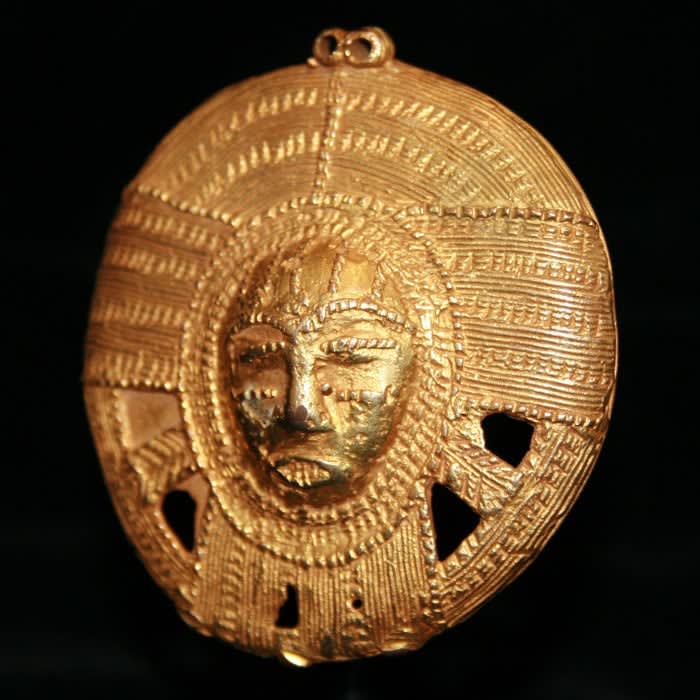Akan Gold Pectoral, 18th Century CE - 20th Century CE
Gold
2.5
DK.001 (LSO)
This beautiful gold pectoral was made by the Akan peoples of what was once appositely named the Gold Coast – now Ghana. It comprises a round gold disk which was...
This beautiful gold pectoral was made by the Akan peoples of what was once appositely named the Gold Coast – now Ghana. It comprises a round gold disk which was evidently made using the lost wax process, decorated with linear patterning, over-folded geometric shapes and a human face in the centre. The face is round topped with a pointed chin, an open mouth, arched brows, narrowed (closed?) eyes, and elevated point scarring or tattooing. The apex is marked with a donble suspension loop. Preservation is excellent although there are small apertures in the lower half of the pectoral, presumably relating to minor casting flaws.
The Akan are a loose assemblage of tribes – including the Akuapem, the Akyem, the Ashanti, the Baoulé, the Anyi, the Brong, the Fante and the Nzema – that share general cultural trends while maintaining separate tribal identities. Their society is highly ritualised, with numerous gods under a main deity who varies according to the group in question (Onyame – the Supreme One – is the Asante deity), and a host of lesser gods (Abosom) who receive their power from the principal god, and are mostly connected with the natural world (earth, ocean, rivers, animals etc).
The Akan consider gold to be the embodiment of sunlight and a physical manifestation of life’s vital force, or “kra”. The economy is based upon the trade in gold, which is most prominently used for the manufacture of regalia for the royal courts. Small secular pieces are also known, but have little social value beyond asserting the wealth of the wearer. The most important pieces are those that send social signals, and that mark out the wearer as something out of the ordinary. For example, “Akrafokonmu” (lit. “soul washer’s disk”) pendants are worn by a series of beautiful young people whose energy replenishes that of the king. This piece may have served such a function.
This rare and beautifully-executed gold masterwork would be the star of any serious collection of African art.
The Akan are a loose assemblage of tribes – including the Akuapem, the Akyem, the Ashanti, the Baoulé, the Anyi, the Brong, the Fante and the Nzema – that share general cultural trends while maintaining separate tribal identities. Their society is highly ritualised, with numerous gods under a main deity who varies according to the group in question (Onyame – the Supreme One – is the Asante deity), and a host of lesser gods (Abosom) who receive their power from the principal god, and are mostly connected with the natural world (earth, ocean, rivers, animals etc).
The Akan consider gold to be the embodiment of sunlight and a physical manifestation of life’s vital force, or “kra”. The economy is based upon the trade in gold, which is most prominently used for the manufacture of regalia for the royal courts. Small secular pieces are also known, but have little social value beyond asserting the wealth of the wearer. The most important pieces are those that send social signals, and that mark out the wearer as something out of the ordinary. For example, “Akrafokonmu” (lit. “soul washer’s disk”) pendants are worn by a series of beautiful young people whose energy replenishes that of the king. This piece may have served such a function.
This rare and beautifully-executed gold masterwork would be the star of any serious collection of African art.
